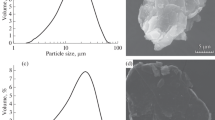Conclusions
-
1.
It has been established that with fall in carbon content the Young's modulus, σtr, and microhardness of titanium carbide decreases.
-
2.
In vacuum friction tests the coefficient of friction of the carbide is directly proportional to its carbon content at temperatures of 20 and 400°C and inversely proportional to it at 1200°C. At 800°C the effect of composition on the coefficient of friction is negligible.
-
3.
The rate of wear of the carbide is proportional to the area of true contact.
-
4.
An x-ray structural analysis has demonstrated that the maxima on curves of physical interference line broadening observed after friction tests at all temperatures correspond to the carbide TiC0.68.
Similar content being viewed by others
Literature cited
Yu. G. Tkachenko, I. I. Timofeeva, A. A. Ragozinskaya, et al., “Deformation behavior of refractory metal carbides during rubbing in a wide temperature range,” Poroshk. Metall., No. 9, 89–93 (1978).
G. V. Samsonov, Yu. G. Tkachenko, and V. V. Sychev, “Wear-resistant carbide materials,” Transactions of the Fifth International Conference in the German Democratic Republic, Vol. 2, Dresden (1973), pp. 39–41.
V. V. Sychev, Yu. G. Tkachenko, and M. S. Koval'chenko, “Apparatus for the investigation of high-temperature friction and wear processes in a vacuum and in gaseous environments,” Fiz.-Khim. Mekh. Mater., No. 5, 77–78 (1971).
G. V. Samsonov, G. A. Bovkun, and A. F. Prisevok, “Abrasive wear resistance of various classes of materials,” Mashinostr. Priborostr., No. 7, 45–52 (1975).
G. V. Samsonov, G. Sh. Upadkhaya, and V. S. Neshpor, Physical Materials Science of Carbides [in Russian], Naukova Dumka, Kiev (1974).
W. S. Williams, J. Appl. Phys.,35, 1329–1338 (1964).
M. E. Demkin, Contact between Irregular Surfaces [in Russian], Nauka, Moscow (1970).
M. S. Koval'chenko, V. V. Dzhemelinskii, V. N. Skuratovskii, et al., “Microhardness of some carbides at various temperatures,” Poroshk. Metall., No. 8, 87–91 (1971).
Yu. G. Tkachenko, S. S. Ordan'yan, V. K. Yulyugin, et al., “Preparation and high-temperature antifrictional properties of eutectic alloys of the MeIVC-MeIVB2 system,” Izv. Akad. Nauk SSSR, Neorg. Mater.,13, No. 8, 1414–1418 (1977).
Author information
Authors and Affiliations
Additional information
Translated from Poroshkovaya Metallurgiya, No. 6(198), pp. 45–51, June, 1979.
Rights and permissions
About this article
Cite this article
Tkachenko, Y.G., Ordan'yan, S.S., Yulyugin, V.K. et al. Frictional characteristics and contact-zone deformation behavior of TiC in its homogeneity range. Powder Metall Met Ceram 18, 387–392 (1979). https://doi.org/10.1007/BF00802327
Received:
Issue Date:
DOI: https://doi.org/10.1007/BF00802327



